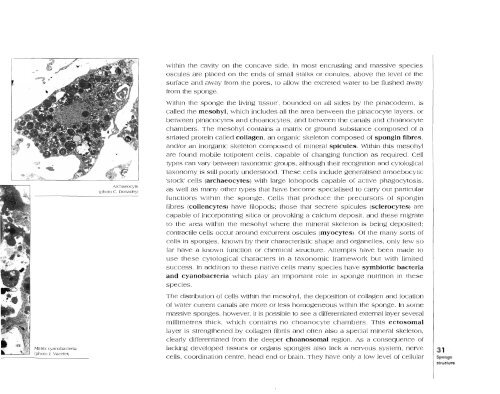Sponges of the New Caledonian lagoon - IRD
Sponges of the New Caledonian lagoon - IRD
Sponges of the New Caledonian lagoon - IRD
Create successful ePaper yourself
Turn your PDF publications into a flip-book with our unique Google optimized e-Paper software.
.,<br />
Matrix cyanobacleria<br />
(photo J. Vacelet)<br />
within <strong>the</strong> cavity on <strong>the</strong> concave side. In most encrusting and massive species<br />
oscules are placed on <strong>the</strong> ends <strong>of</strong> small stalks or conules, above <strong>the</strong> level <strong>of</strong> <strong>the</strong><br />
surface and away from <strong>the</strong> pores, to allow <strong>the</strong> excreted water to be flushed away<br />
from <strong>the</strong> sponge.<br />
Within <strong>the</strong> sponge <strong>the</strong> living 'tissue', bounded on all sides by <strong>the</strong> pinacoderm, is<br />
called <strong>the</strong> mesohyl, which includes all <strong>the</strong> area between <strong>the</strong> pinacocyte layers, or<br />
between pinacocytes and choanocytes, and between <strong>the</strong> canals and choanocyte<br />
chambers. The mesohyl contains a matrix or ground substance composed <strong>of</strong> a<br />
striated protein called collagen, an organic skeleton composed <strong>of</strong> spongin fibres,<br />
and/or an inorganic skeleton composed <strong>of</strong> mineral spicules. Within this mesohyl<br />
are found mobile totipotent cells, capable <strong>of</strong> changing function as required. Cell<br />
types can vary between taxonomic groups, although <strong>the</strong>ir recognition and cytological<br />
taxonomy is still poorly understood. These cells include generalised amoebocytic<br />
'stock' cells (archaeocytes) with large lobopods capable <strong>of</strong> active phagocytosis,<br />
as well as many o<strong>the</strong>r types that have become specialised to carry out particular<br />
functions within <strong>the</strong> sponge. Cells that produce <strong>the</strong> precursors <strong>of</strong> spongin<br />
fibres (collencytes) have filopods; those that secrete spicules (sclerocytes) are<br />
capable <strong>of</strong> incorporating silica or provoking a calcium deposit, and <strong>the</strong>se migrate<br />
to <strong>the</strong> area within <strong>the</strong> mesohyl where <strong>the</strong> mineral skeleton is being deposited;<br />
contractile cells occur around excurrent oscules (myocytes). Of <strong>the</strong> many sorts <strong>of</strong><br />
cells in sponges, known by <strong>the</strong>ir characteristic shape and organelles, only few so<br />
far have a known function or chemical structure. Attempts have been made to<br />
use <strong>the</strong>se cytological characters in a taxonomic framework but with limited<br />
success. In addition to <strong>the</strong>se native cells many species have symbiotic bacteria<br />
and cyanobacteria which play an important role in sponge nutrition in <strong>the</strong>se<br />
species.<br />
The distribution <strong>of</strong> cells within <strong>the</strong> mesohyl, <strong>the</strong> deposition <strong>of</strong> collagen and location<br />
<strong>of</strong> water current canals are more or less homogeneous within <strong>the</strong> sponge. In some<br />
massive sponges, however, it is possible to see a differentiated external layer several<br />
millimetres thick, which contains no choanocyte chambers. This ectosomal<br />
layer is streng<strong>the</strong>ned by collagen fibrils and <strong>of</strong>ten also a special mineral skeleton,<br />
clearly differentiated from <strong>the</strong> deeper choanosomal region. AS a consequence <strong>of</strong><br />
lacking developed tissues or organs sponges also lack a nervous system, nerve<br />
cells, coordination centre, head end or brain. They have only a low level <strong>of</strong> cellular<br />
31<br />
Sponge<br />
struc:ture

















